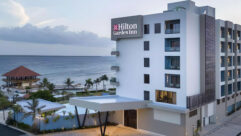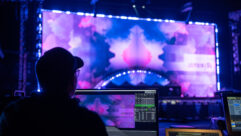
Onsite: Indian Wells Tennis Garden
Jun 7, 2013 3:31 PM,
By Cynthia Wisehart

For two weeks every spring, the AV systems at the Indian Wells Tennis Garden (IWTG) swings into action for the BNP Paribas Open, considered the “fifth Grand Slam” and one of the great marquee events in professional tennis. The rest of the year, the IWTG calendar fills up with local nail-biters like the Midweek Mixup and the De Anza League Boys Playoffs; the club’s members volley on the same courts that hosted Rafael Nadal and Maria Sharapova.
The facility near Palm Springs, opened in 2000 as the second largest tennis stadium in the world. Oracle founder Larry Ellison bought it in 2008 and is now funding an expansion that has been underway since mid-March. Here is something fun to do: go to www.iwtg.net/Site-Expansion-2014 and look at the live webcam and time-lapse movie of the construction, which will be complete by the time the BNP Paribas Open returns in 2014.

Director of Technical Services Dave Sahl is up to his neck in the expansion, which also includes an extension of the AV systems. Sahl has supplied technical support for the BNP Paribas Open for many years, first as a contractor and then in his position at IWTG. On his watch, the systems have been updated in effective—but not flashy—ways. As he walks me around the grounds during the BNP Paribas Open, the place feels like a casual county fair that just happens to be hosting a ruthless tennis competition. There are flatscreens and videowalls set up throughout the grounds—in the outdoor food courts, ticket, admin, and player areas—with live feeds from the eight courts, scoring data, sponsor messages, and various cable feeds. Guests don’t need to worry about missing a moment.

The facility has undergone a measured transition from analog to digital. In 2011, they replaced all the main Community Professional WET 228 loudspeakers with new ones, and also refreshed the OWI balcony speakers and the JBLs in the suites. At that time, a transition from IED to CobraNet/SimNet brought significant improvements to clarity, zoning, delay, and EQ, and eliminated the mystery noise episodes that occasionally rattled the system. It also allow Sahl to get sources, especially audio from the various Shure mics, to more places. The new stadium will have a Dante network that will interface with existing CobraNet through a design by Show Factory’s Marc Jones.
When the flatscreens were added through the grounds (including one for each of the 113 press seats), Sahl was able to build an internal HD cable network—19 custom HD channels—plus a standard CATV lineup. Some of the facility screens are supplied directly via fiber from a Brainstorm unit in the production office. But the bulk of the screens receive modulated signal. The new 7,000-seat stadium and its four restaurants will receive the same 19 HD channels.

PRODUCT AT WORK: Contemporary Research QMOD
Flatscreens throughout BNP Paribas Open are served by 19 QMOD-HD digital modulators and QMOD-HDSC with scalers for sources that have computer graphics overlay.










